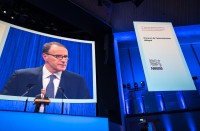
The powerful young prince overseeing Saudi Arabia’s economy unveiled ambitious plans on Monday (April 25) aimed at ending the kingdom’s “addiction” to oil and transforming it into a global investment power.
Deputy Crown Prince Mohammed bin Salman said the kingdom would raise the capital of its public investment fund to 7 trillion riyals ($2 trillion) from 600 billion riyals ($160 billion).
He added that the world’s top oil exporter expects state oil company Saudi Aramco to be valued at more than $2 trillion ahead of the sale of less than 5 percent of it through an initial public offering (IPO).
The plans also included changes that would alter the social structure of the ultra-conservative Muslim kingdom by pushing for women to have a bigger economic role and by offering improved status to resident expatriates.
His “Vision 2030” envisaged raising non-oil revenue to 600 billion riyals ($160 billion) by 2020 and 1 trillion riyals ($267 billion) by 2030 from 163.5 billion riyals ($43.6 billion) last year. But the plan gave few details on how this would be implemented, something that has bedevilled previous reforms.
At the centre of the plan is the restructuring of its Public Investment Fund (PIF), which Prince Mohammed said would become a hub for Saudi investment abroad, partly by raising money through selling shares in Aramco.
Asked where Riyadh would find the funds for a $2 trillion dollar fund after recent borrowing, he said it would come from transferring the ownership of Aramco to the PIF.
The partial privatisation of Aramco was also central to the plans, and Prince Mohammed said it would be transformed into an energy company that he expected to be valued at $2 trillion to $3 trillion, and that less than 5 percent of it would be listed on the stock market.
So big is the state oil company because of its rights to the kingdom’s crude reserves, that selling even 1 percent of its value would create the biggest initial public offering (IPO) on earth, he said.
He said other Aramco subsidiary companies would also be listed along with other publicly held companies, and added that one major benefit of privatisation was that it would increase transparency and help limit corruption.
Prince Mohammed has enjoyed a dizzyingly rapid rise since his father became king 15 months ago, from being little known outside the ruling Al Saud family to become the driving force of Saudi plans to prepare for a future after oil.
Reuters







